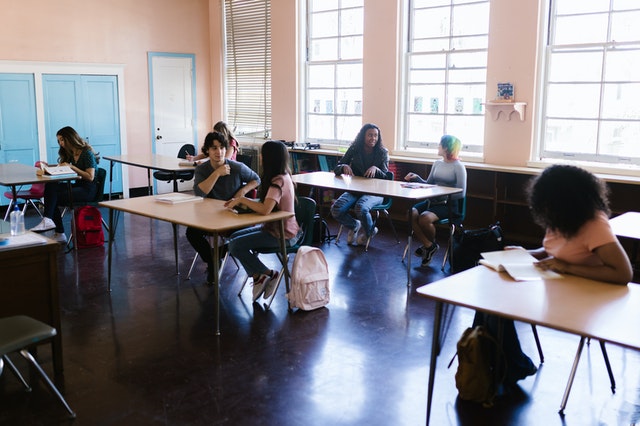Teaching is a constant learning process. Teachers have to constantly learn new things and develop innovative classroom management strategies to improve education standards in their classes.
Math & ELA | PreK To Grade 5
Kids see fun.
You see real learning outcomes.
Watch your kids fall in love with math & reading through our scientifically designed curriculum.
Parents, try for free Teachers, use for free
As a teacher, you have to develop classroom management strategies to keep your students engaged in their studies. However, it’s not easy to design engaging classroom management strategies—especially for new teachers.
It’s something that teachers learn with experience. But in today’s day and age, most teachers are overwhelmed with their hectic schedules.
No need to worry because we have mapped the best classroom management strategies that you can implement in your class today. So, let’s get started.
30 Effective Classroom Management Strategies for Teachers

According to a study at the University of Missouri, negative attention rebukes like “stop chit-chatting” or “don’t look around” might momentarily stop your students from indiscipline. However, it will stimulate disruptive behavior among students. The study also found that negative rebuke makes students feel disengaged, less concentrated, and face difficulty controlling their emotions.
Therefore, it is important for teachers to plan classroom management strategies to improve students’ performance and not disengage them. It might look hard to do, but you can better manage and engage your students by following a few simple tricks.
Individual Classroom Management Strategies

1. Use Digital Learning Methods
Provide educational technologies to your students who are struggling to learn in your classroom. You can adjust lessons based on your individual students’ understanding levels using online teaching tools.
Besides this, you can use games to make learning interesting for your class. For example, SplashLearn’s math games will help preschool teachers make counting, dividing, and subtracting an engaging process for their pupils.
2. One-on-One Interaction
The best individual classroom management strategy is having one-on-one interaction with your students. Teachers can sit with each student and ask them some basic questions to understand how they are learning in the class, such as:
- How do they feel about the particular lesson?
- What makes them learn better?
- Which subjects do they feel are hard or easy?
- What are their favorite class activities or lessons?
- Which exercises help them better remember lessons?
Related Reading: Interesting Social-Emotional Learning Activities for Classroom
3. Use the Peer Teaching Method
The best strategy to avoid students’ disengagement in the classroom is peer teaching. In this classroom management strategy, you can pair top performers with disruptive and struggling students.
For example, you can pair students as reading partners to benefit students with low confidence and poor interpersonal skills by pairing them with someone with strong social skills.
4. Tackle Inappropriate Behavior Immediately
Don’t neglect the situation if you find a student misbehaving in the classroom. You should, as soon as possible, address the inappropriate behavior.
The longer you delay tackling the misconduct in your class, the more chaos or negative feelings it will develop.
When a student breaks a documented rule or misbehaves with his peers, take him to the side and tell him that this is wrong behavior and you will not tolerate it in your class. Also, don’t scold students before their peers, as it may invoke more negative feelings.
5. Use Reward System
The carrot and stick theory is a classic classroom management strategy. When you give some reward to students for following the classroom rules, good behavior, or scores, it will motivate them to do even better.
In fact, it will encourage other students to work harder to receive rewards and recognition from their class teacher.
Group Classroom Management Strategies

6. Spotlight Class Rules
Implementing group classroom management strategies helps to save time and improve discipline level in your classroom. So, first of all, jot down all the rules that you want to deploy in your class and share them with everyone.
You can email a copy of the classroom rules to all the parents. Or, you can create a rule bulletin to make it clear to everyone – what’s acceptable and unacceptable in your class.
7. Erase-a-Letter Technique
This is a simple yet effective group classroom management strategy. Before starting a classroom activity, provide your students with a clear set of rules and write the STOP word on the blackboard.
When students break the rule, erase a letter from the blackboard. Keep on going unless all letters are erased. After that, you can stop the activity and tell your students that you won’t continue unless they start following the rules.
8. Classroom Economy System
The classroom economy system is exactly how it reads. You have to create a dummy currency that works in your classroom. And, for every good behavior or grade, you can distribute classroom money to your students. Finally, at the end of the week or month, calculate the money earned by each student.
Moreover, you can auction different classroom components that students can purchase with money—for example, an extra-long lunch break, no homework Friday, etc.
9. Use Traffic Light Signals
Traffic light signals are an interactive classroom management strategy. You need to attach a classroom environment to all three traffic light colors. For example, Red – Silence, Yellow – Whispers, and Green – Discussion.
So, now whenever you want silence in your class, say it is a red light, and your class will understand that they need to keep quiet for now. You can make this strategy more interesting – simply put red, yellow, and green light bulbs in your class and switch on the bulb according to your classroom environment.
10. Issue a Raffle Ticket
Taking inspiration from the traffic light strategy, you can also follow a raffle ticket method. In this strategy, give two raffle tickets to each student at the beginning of your class.
You can take a raffle ticket from students when they break any rule. Once a student loses all two tickets, you can give them constructive punishment like extra pages for reading, helping the teacher organize the classroom, etc.
Related Reading: Implementing Restorative Practices In The Classroom
Preschool Classroom Management Strategies

11. Divide your Classroom into Zones
Managing a class full of preschoolers is not easy. You have to constantly be on your toes to prevent the class from becoming a war zone. Thus, preschool teachers’ perfect classroom management strategy is to divide their classrooms into zones.
You can divide your classroom into zones like quiet zones, play zones, etc. This way, your preschoolers will know how to behave and what to do in every zone. For instance, when you take your class to a quiet zone, they will automatically know they must stay quiet now.
12. Practice Reassurance and Emotions
You can’t teach anything to preschoolers by scolding or punishing them. You have to keep a warm and calm demeanor while dealing with preschoolers.
Children start to develop their senses to understand actions and emotions at the age of 3 years. Thus, sometimes hugging a child who is sitting alone or talking to a troublemaker in your class is the best way to manage your class.
13. Provide an Outlay to Express
Children might start to understand emotions at the age of 3 years. But preschoolers are still learning to express their emotions. Sometimes children get upset over small things when they aren’t well or sleep-deprived.
Thus, teachers need to provide a creative outlay to preschoolers so they can express their emotions. For instance, ask your class to draw a painting, write a song or enact their emotions. This way, your students might express their emotions and, in return, will help you understand why a student behaves in a particular manner.
14. Plan Transitions
It is hard to switch preschoolers from one activity to another. Specifically, asking preschoolers to stop playing and take a nap is challenging.
Therefore, you should include transitions in the routine of your class. Before taking them to the play zone, tell them that they only have a set time to play, and after that, they have to move on to another activity.
Also, keep on reminding them how much time is left for the activity. This will prepare the students for transitions.
15. Follow the Class
Sometimes behaving like a preschooler will better help you teach preschoolers. So, if you find your class in a playful mood, you can also follow in their footsteps.
Preschool teachers must adopt a flexible classroom management approach to keep students engaged throughout the day.
Elementary School Classroom Management Strategies

16. Set Rules with Logic
Elementary school students are curious bees. They want to know the reason behind everything. Therefore, you should not just tell them the rules. You should define the reason behind a particular rule and what will happen if they don’t follow it.
For example, if you have set a rule to not run in the school corridor, tell students that you don’t want them to get hurt by slipping on the tiled floor, and that’s why you’ve set the rule.
When your students understand the reason behind the rules, they will better follow them without your interference.
17. Make Students Responsible for Their Own Learning
If you impose rules on your students, they will definitely repulse them. It’s fundamental human nature to do when we are asked not to do a certain thing.
Therefore, instead of asking your students to follow the rules, ask them to make rules to help them learn in the classroom. You should even make students responsible for their own learning environment. Ask them to check on themselves and see whether they are achieving their set learning goals or not.
18. Praise without Personal Bias
Praising students is an important management strategy. But, you should check your tone while praising your students. That’s because sometimes, without even realizing it, you might use a biased tone that can impact the morale of other students.
Instead of saying, “I liked how Robert has done his homework on time,” you should say, “Robert has completed his homework on time, and now it’s your turn.”
19. Build a Relationship with Parents
Creating a positive classroom environment will become easier when teachers, parents, and students are on the same page. You can better handle the situation with your students when you conduct open dialogues with parents.
You should encourage parents to participate in parent-teacher meetings and provide constructive feedback to create a better learning environment in the classroom. Moreover, a strong bond between parents and teachers will help improve the overall education level of your class.
20. Grab the Class’ Attention
Before resuming the class, you should first direct your students’ attention to the blackboard. You can grab your class’ attention using simple things like requesting them to raise their hands.
You can also say to your class that you are beginning the lesson and want complete quiet in the class. Since elementary school students are more mature than preschoolers, simply saying will be sufficient to grab their attention.
Middle School Classroom Management Strategies

21. Stay Consistent
If you have set a rule in your class, stick to it. Don’t change your class rules after a few days because it only confuses parents and students. Also, be consistent with your punishment and reward methods.
22. Students Are Not Your Friends
It is a good idea to have a healthy relationship with your students. But, you should create a boundary between you and your students. That’s because if you allow your students to behave loosely with you, it will only make it difficult for you to manage them later on.
23. Always Use Positive Tone
Always remember, an eye for an eye will make the whole world blind. Therefore, if your student is talking in a rude or negative tone, you should keep calm and speak positively. Your calming tone will also help to relax your student.
24. Own Up to Your Mistakes
Teachers are also humans. They can also make mistakes. Therefore, if you have made a mistake in your class, demonstrate positive behavior by owning up to your mistake.
When your students see that you are accepting your mistakes openly, it will also encourage them to accept their mistakes without any hesitation.
25. Don’t Give Too Many Options
Giving options to your middle schoolers is a good idea. But don’t give them too many options because it will overwhelm them in the end. You should let your middle school students make their own decisions. However, provide them with two or three options to choose from so they can make the right decision without getting flustered.
Related Reading: Classroom Organization Ideas to Make Teaching Productive
High School Classroom Management Strategies

26. Create Comic Environment
According to research, the human brain responds positively to laughter due to the surge of endorphin, epinephrine, and dopamine. Thus, you should incorporate some comedy elements while narrating rules to your high schoolers. For example, you can prepare a small standup comedy act to introduce class rules to your students.
27. Be Confident
It is not easy to make teenagers follow the rules. Sometimes you might even feel unconfident while managing high school classes. Therefore, no matter how frustrated you feel from the inside, you should never lose your confidence in front of your class.
28. Be Honest and Real
Don’t sugarcoat things for your high school students like middle schoolers. The more you show your real side to them, the better they will connect with you. So, try to be as honest and real with your high school students.
29. Learn Your Students Names
You should learn the names of all your students right away. Calling students by their names will help you to build a healthy relationship with them.
30. Demand Respect
Make it clear to your high school students on the first day that you don’t request respect; you demand it. No matter what your age is, your students have to respect you.
Just Be Flexible!
After going through all the classroom management strategies, you must have a fair idea about which strategy will work best in your class. However, on the parting thoughts, we would like to suggest that you should be flexible with your classroom management style.
Depending upon the behavior and nature of your students, you should constantly change your management approach. This way, you can build healthy relationships with your students without compromising rules.
What are the main 3Cs of classroom management?
You can create an innovative classroom management strategy using the main 3C principles, including consistency, compassion, and connection.
What is a classroom management plan?
A classroom management plan is a set of rules based on which your class will operate. This plan will tell your students which behavior is acceptable in the class and which is not. A classroom management plan will work as a guide for teachers to implement new rules and procedures in the classroom.
What are the essential parts of classroom management strategies?
The four essential parts of classroom strategies are autonomy, competence, relatedness, and relevance.
























